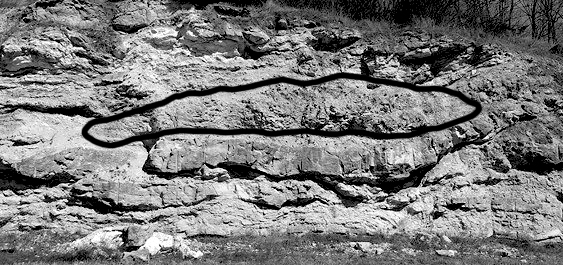Of Stromatolites and Bioherms EarthCache
Of Stromatolites and Bioherms
-
Difficulty:
-

-
Terrain:
-

Size:  (other)
(other)
Please note Use of geocaching.com services is subject to the terms and conditions
in our disclaimer.
As one travels along US 50 in Gasconade County, numerous road cuts present thmselves to the driver. Most are fairly nondscript, offering not much more than a glimpse into the local rock strata and the various colors of those varying kinds of rocks. Sometimes, however, there is something special lurking in those exposed rock faces. Maybe it's a filled sinkhole, maybe it's an anticline or a syncline. Maybe it's a bioherm. This Earthcache will exhibit the latter, and hopefully once you depart, you'll get to know bioherms better and be on the lookout for them yourself.
What are Bioherms?
Bioherms are masses of rock constructed nearly entirely of the remains of marine organisms. They typically are round or oval in shape and are separated from surrounding rock by distinct bedding planes. Bioherms are found in many Paleozoic carbonate rocks in Missouri, and are often composed of piles of fossil corals, crinoids, or brachiopods. During Cambrian and Ordovician time, they consisted mostly of mounds of thinly-layered carbonate sediment trapped by colonies of algae that grew in very shallow water and projected above the sea floor. The fossilized algae colonies are called stromatolites.
What are Stromatolites?
Stromatolites (Greek for ‘layered rock’) are microbial reefs created by cyanobacteria (formerly known as blue-green algae). Stromatolite deposits are formed by sediment trapping and binding, and/or by precipitation activities of the microbial communities. The microbes are active on the surface layer of the stromatolites, while the underlying build-up is a remnant of former microbial surface communities. These deposits built up very slowly...a single structure three feet tall may be 2,000 to 3,000 years old! The tiny microbes that make up modern stromatolites are similar to organisms that existed 3.5 billion years ago! Consider that the Earth itself has been around for 4.5 billion years, and that Homo sapiens have only been on Earth for 195,000 years, give or take a few thousand.
Stromatolites are the reason why we’re alive today. Before cyanobacteria, the air was only 1% oxygen. Then, for 2 billion years, our photosynthesizing stromatolites pumped oxygen into the oceans. When the oceans’ waters were saturated, oxygen was released into the air, and with around 20% of oxygen in the air, life was able to flourish and evolve.
The Earthcache
Time to check out this neat bioherm.
To access this roadside Earthcache, you'll need to pull off to the side of US 50. You can do this one coming from either direction, as there's plenty of space to pull over safely. Watch the kids if you have them, as it's a fairly busy highway.
At the posted coordinates, you'll see the bioherm located in an outcrop of the Jefferson City Dolomite. At this spot, you'll be able to do all the necessary tasks to complete this Earthcache. Can't find it? Here, I've outlined the bioherm for you...

Earthcache Tasks
To get credit for this Earthcache, answer the questions below and email those answers to me through my profile.
Any logs that do not follow these requirements will be deleted.
1. What color of rock is the bioherm?
2. Approximately how high is the bioherm above ground level?
3. How long is the bioherm? How tall is it at its thickest point?
4. What is a bioherm?
5. What is a stromatolite?
Taking a photo of yourself with bioherm behind you would be nice and is most certainly encouraged, but it is not required.
Source Used
• Spencer, Charles G. Roadside Geology of Missouri. Missoula, Montana: Mountain Press Publishing Company, 2011. 21, 176. Print.

Additional Hints
(No hints available.)